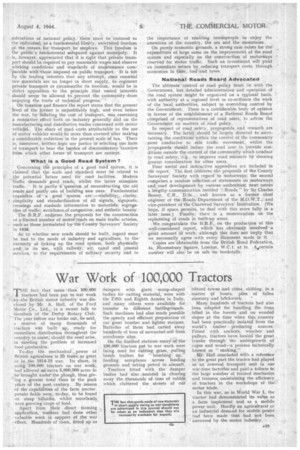War Work of 100,000 Tractors
Page 25

If you've noticed an error in this article please click here to report it so we can fix it.
THE tact that more than 100,000 tractors had been put to war work by.the British motor industry was disclosed by Mr. A. Hall, of the Ford Motor Co., Ltd., in a recent talk to members of the Derby Rotary Club. The year before war broke out, he said, a reserve of many thousands of tractors was built up, ready for immediate distribution throughout the country to assist, should the need arise, in meeting the problem of increased food production.
To-day the mechanical , power of British agriculture is 25 times as great as in the 1914-18 war. Its share, in using 100,000 tractors on war work, bad allowed an extra 5,000,000 acres to be brought under the plough, thus giving a greater total than in the peak years of the past century. By reason of the capabilities of the farm tractor. potato fields were, to-day, to be found on steep hillsides, whilst moorlands were growing crops of food. '
Apart from their direct farming application, tractors had done other valuable work in support of the war effort. Hundreds of them, fitted up as dumpers with giant scoop-shaped bodies for carting material, were with the Fifth and Eighth Armies in Italy, and many others were available for transfer to different battlegronnds. Such machines had also made possible the speedy and efficient preparation of our great bomber and fighter stations. I3atteries of them had carted away hundreds of tons of unwanted soil from aerodrome sites.
On the finished stations many of the 100,000 tractors put to war work were being used for cutting grass, pulling bomb trailers for " bombing up," hauling aeroplanes across landing grounds and taking petrol to aircraft.
Tractors fitted with the dumper bodies had also assisted in clearing away the thousands of tons of rubble which cluttered the streets of our blitzed towns and cities, shifting, in a matter cif hours, piles of fallen masonry and brickwork. '
Many hundreds of tractors had also been adapted for handling the trees felled in the forests and on wooded slopes at the time when this country had been practically isolated from the world's timber producing sources. Fitted with anchors, winches and pulleys, tractors have hauled the great trunks through the undergrowth of copse and wood—a process technically known as "snaking."
Mr. Hall concluded with a reference to the great part the tractor had played as an internal transport unit in our war-time factories and paid a tribute to the large number of trained mechanics and trainees, maintaining the efficiency of tractors in the workshops of the motor trade.
In this war, as in World War I, the tractor had demonstrated its Value as a farm implement and as a mobile power unit. Hardly an agricultural or an industrial demand for mobile power had been made that had tot been answered by the motor industry.




















































